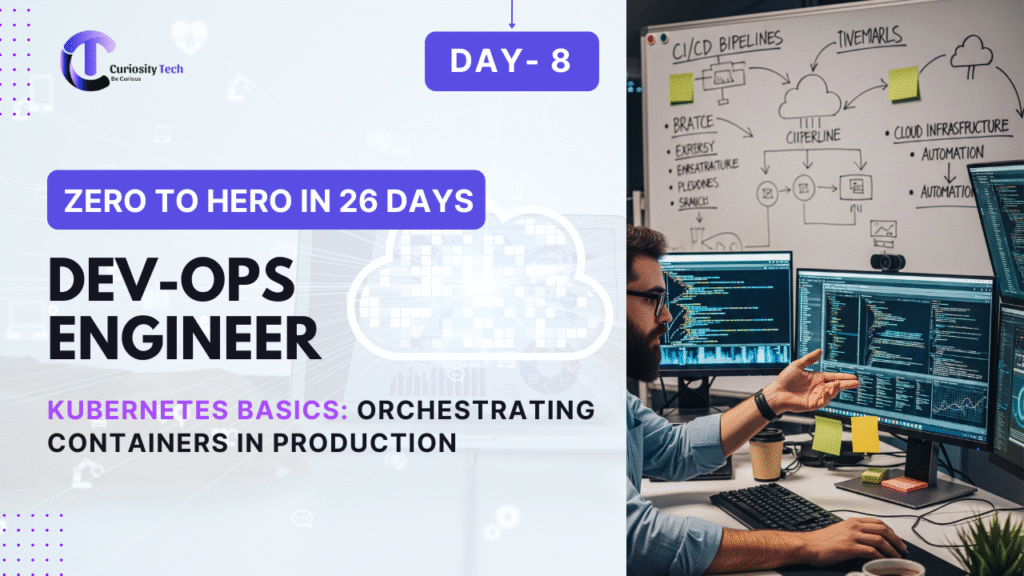In modern DevOps ecosystems, Kubernetes (K8s) has become the de facto standard for container orchestration. While Docker allows developers to package applications into containers, Kubernetes ensures these containers run reliably and scale efficiently in production environments. At CuriosityTech.in, we guide aspiring DevOps engineers through both theory and hands-on implementation to master K8s.
What is Kubernetes?
Kubernetes is an open-source container orchestration platform that automates the deployment, scaling, and management of containerized applications. Originally developed by Google, K8s addresses the complexity of running applications at scale across clusters of machines.
Key Benefits of Kubernetes:
1. Scalability – Automatically scale containers based on resource usage.
2. High Availability – Self-healing features replace failed containers.
3. Load Balancing – Distributes traffic evenly across containers.
4. Resource Optimization – Efficiently utilizes hardware resources across nodes.
5. Extensibility – Supports custom extensions, operators, and plugins.
Core Concepts of Kubernetes
Understanding Kubernetes requires familiarity with its core components and architecture:
| Component | Description |
| Pod | Smallest deployable unit in K8s; can contain one or more containers. |
| Node | Worker machine in the cluster, either physical or virtual. |
| Cluster | Set of nodes managed by K8s to run applications. |
| Deployment | Declarative object defining the desired state of Pods. |
| Service | Abstracts Pods and provides stable endpoints for communication. |
| Namespace | Logical partitioning of resources in a cluster. |
| ConfigMap & Secret | Manage configuration and sensitive data respectively. |
| Ingress | Manages external access to services, typically HTTP/HTTPS. |
Kubernetes Architecture Diagram
Description: The master node manages the cluster via the API server, scheduler, and controllers, while worker nodes (Nodes 1-3) run Pods, each containing containers. Kubelet ensures Pods run as expected.
Kubernetes Workflow for Beginners
1. Write Deployment YAML – Define application, replicas, and container images.
2. Apply Configuration – Deploy resources using kubectl apply -f <file>.yaml.
3. Monitor Pods & Services – Check status using kubectl get pods and kubectl get svc.
4. Scale Application – Use kubectl scale deployment <name> –replicas=<number>.
5. Update Application – Rolling updates allow zero-downtime deployments.
6. Access Logs & Debug – kubectl logs <pod> helps troubleshoot issues.
Practical Example: Deploying a Simple Web Application
Deployment YAML Example:
apiVersion: apps/v1
kind: Deployment
metadata:
name: web-app
spec:
replicas: 3
selector:
matchLabels:
app: web
template:
metadata:
labels:
app: web
spec:
containers:
– name: web
image: nginx:latest
ports:
– containerPort: 80
Steps:
1. Apply deployment: kubectl apply -f web-deployment.yaml
2. Check pods: kubectl get pods
3. Expose service: kubectl expose deployment web-app –type=LoadBalancer –port=80
4. Access via external IP: kubectl get svc
At CuriosityTech.in, we emphasize hands-on learning. Deploying multi-container applications on Minikube or cloud clusters (AWS EKS, Azure AKS, GCP GKE) accelerates understanding.
Kubernetes vs Docker Swarm
| Feature | Kubernetes | Docker Swarm |
| Complexity | High, steeper learning curve | Low, simpler for small projects |
| Scalability | Highly scalable, ideal for large clusters | Less suitable for large-scale clusters |
| Rolling Updates | Supported with zero downtime | Supported but limited features |
| Community & Support | Large, extensive ecosystem | Smaller community |
| Extensions & Ecosystem | Rich ecosystem (Helm, Operators, Custom Controllers) | Limited extensions |
Best Practices for Kubernetes Beginners
1. Use Namespaces – Isolate environments (dev, staging, production).
2. Leverage ConfigMaps and Secrets – Manage config and sensitive info safely.
3. Adopt Helm – Simplifies complex deployments through reusable charts.
4. Enable Monitoring – Use Prometheus and Grafana to track performance.
5. Understand Resource Requests & Limits – Prevent resource starvation in clusters.
Mastery comes from deploying real applications in multi-node clusters, troubleshooting Pods, and configuring services for production workloads.
Challenges & How to Overcome
| Challenge | Solution |
| Steep Learning Curve | Start with Minikube or Kind (local clusters). |
| Networking Complexity | Study ClusterIP, NodePort, and LoadBalancer networking models. |
| Resource Management | Set CPU & memory limits for Pods. |
| Debugging | Use kubectl describe, logs, and events to troubleshoot. |

